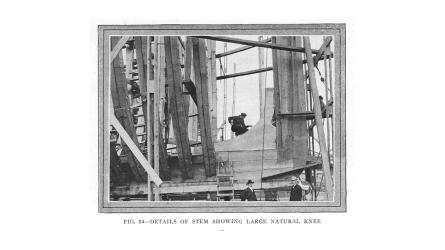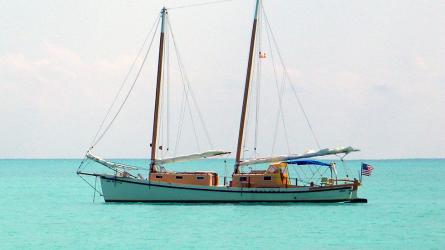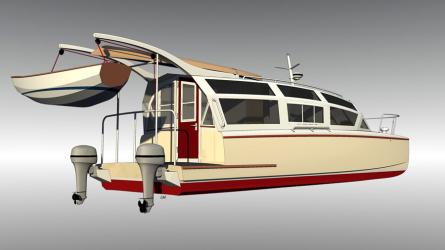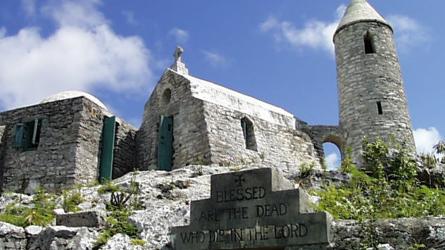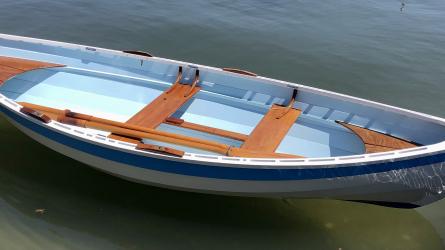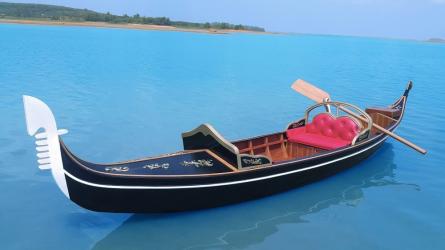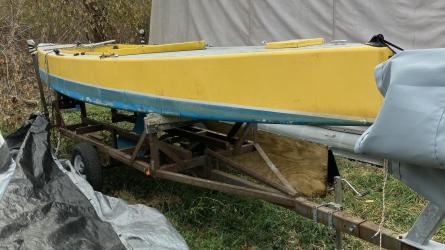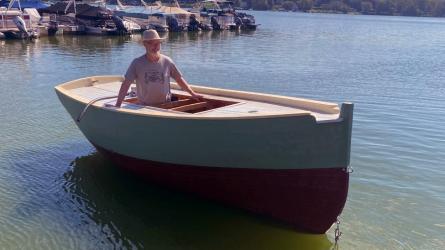The Pacific Class Sloop
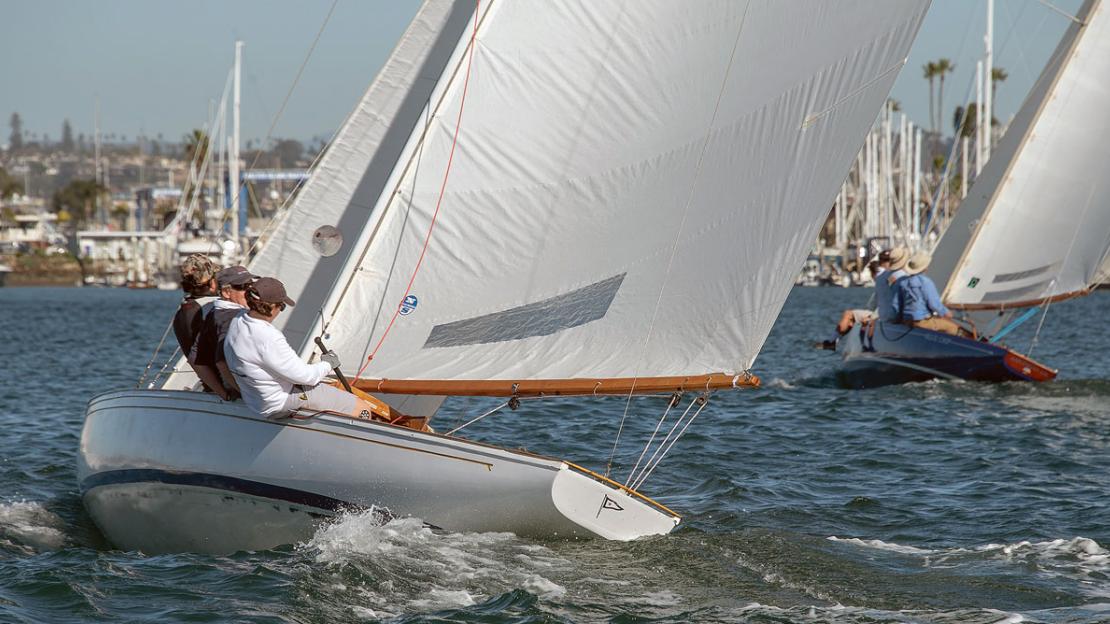
The crew on ROUTE 66 hikes hard during the final charge to the finish line of the first 2019 Sun Series Race. To leeward of them is BLUE CHIP (No. 43), also recently restored by her owner, Chris Frost. BLUE CHIP was owned by the PC Class’s designer, Paul Kettenburg, and Frost sailed on her as a teenager. Many PCs have been handed down to owners who are willing and able to oversee restorations.
Legend has it that on the storied waters off San Diego, California, where Dennis Conner defended the AMERICA’s Cup not so long ago, there has been an unusual gathering of what some in nautical circles call “angels.”
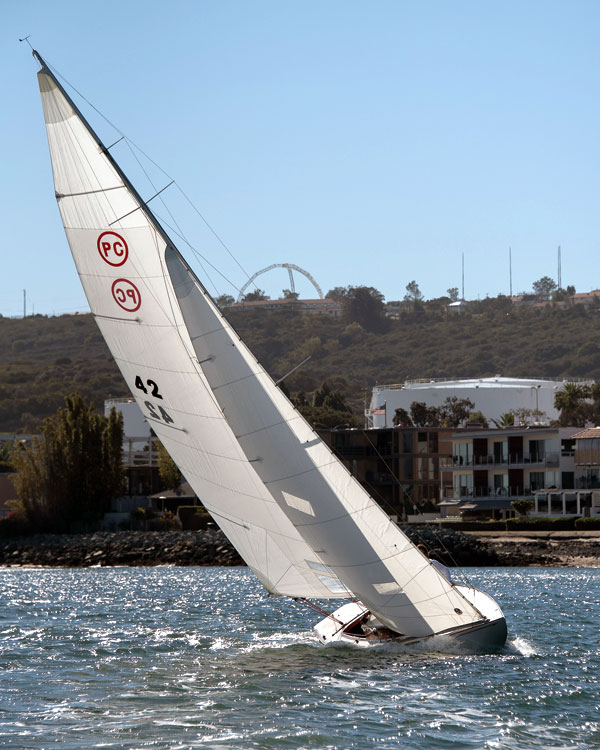
In San Diego, California, the Pacific Class (PC) sloop ZEST, built in 1942 and recently restored, works to windward with owner Steve Brownsea at the helm. The first PC was launched in 1929, and the class is still actively raced.
Those angels have built, sailed, and nurtured a class of large and sleek knockabout sloops known affectionately as “PCs.” The Pacific Class was the first one-design racing sloop constructed for Southern California waters, and over the past 90 years this class of about 80 boats has sailed into yachting mythology. WINGS, hull No. 8 and perhaps the oldest hull in existence, is on display at the San Diego Maritime Museum.
PCs have attracted an enthusiastic following for about four generations. Today, 18 of them line up in their slips on E Dock at the San Diego Yacht Club (SDYC) like a concours d’élégance of trophy boats, and another dozen lie at various locations around San Diego. On weekends they raise their sails for jaunts or races around San Diego Bay. When first built in 1929, the PC sloop was conceived as a club and class racer within the price range of sailors of ordinary means who could maintain their own boats. But today a restored PC can cost you well over $50,000, which is no modest outlay for a daysailer.
I asked Rish Pavelec, who has rescued quite a few PCs, what the boat’s big attraction is. He paused, then his voice began to almost purr as he spoke. He said the PC looks just like the sailboat you see in your dreams. “It looks the way a sailboat should look.”
Dr. Alex Caldwell, who grew up sailing and racing PCs with his parents, is a glider plane enthusiast. He says that sailing his late father, Bud’s, Pacific Class ONION TRUCK is as close as you can come on the water to piloting a glider. “It’s like soaring.”
After hearing such testimonials, I thought I owed it to myself to go in search of the magic. So it was on a windy March afternoon in San Diego that I found myself in the cockpit of PC No. 16, DAWN, built in 1934 and recently restored. Our crew of four included three sailors who are among the current angels shepherding the PC toward its centennial. Aboard and calling the shots was DAWN’s restorer, the Pied Piper of San Diego’s wooden boat renaissance, C.F. Koehler. He’s a 54-year-old wooden boat guru, president of the family Koehler Kraft yacht yard, professional skipper, and inspired jazz trumpeter. Amanda Del Bello and Danielle Richards, two of the “young bloods” in the PC fleet, were tending the jib.
DAWN has no engine, and freeing her from her berth deep amid a warren of docks and boat slips seemed to me like an accident waiting to happen. So I was not all that excited to take the helm. But as soon as we shoved off the dock and Koehler began hoisting the mainsail, I felt DAWN’s helm come alive in my hand. She pivoted through the twists, turns, and narrow fairways like a smart, little junior racer a third her size.
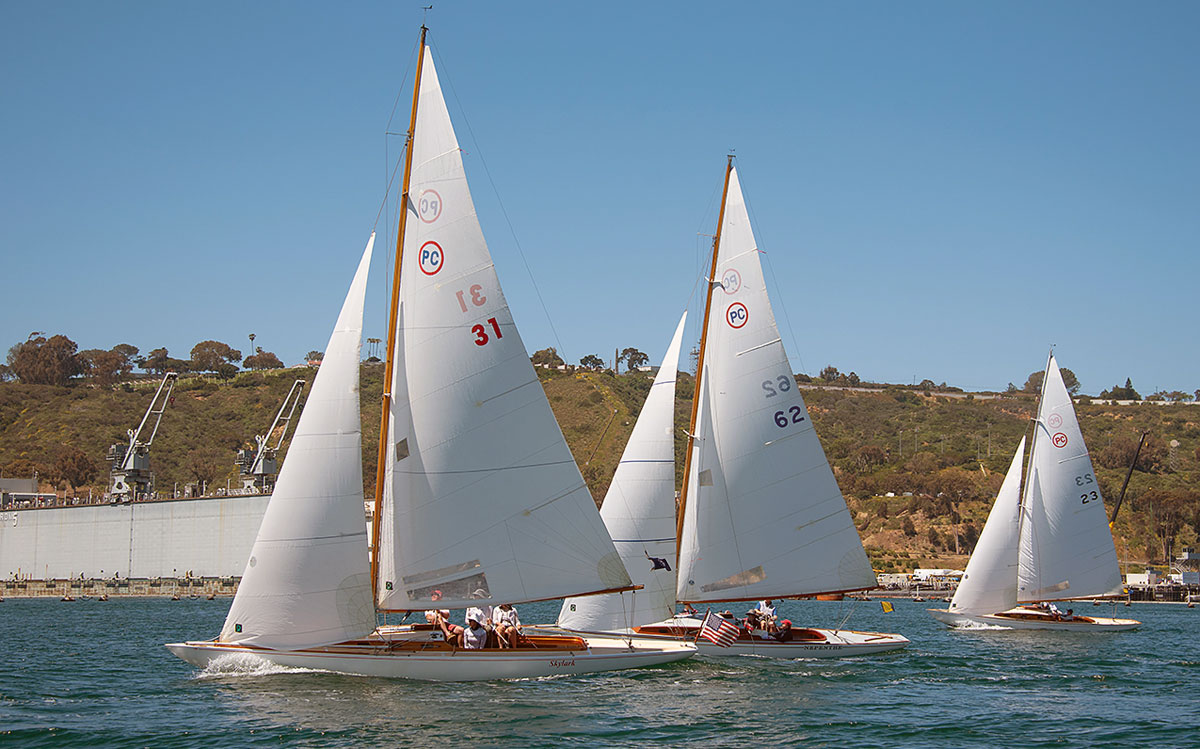
SKYLARK (No. 31) was skippered by Commodore Jerelyn Biehl in the 2019 San Diego Yacht Club (SDYC) Opening Day race. The boat had a doghouse, which was removed to enlarge the cockpit. NEPENTHE (No. 62) and ROUTE 66 (No. 66, though the sail says 23) are in the background.
In the open waters of San Diego Bay, she really showed her nimbleness as she slalomed amid the Saturday afternoon boaters motoring about in swarms. Folks on other boats cheered as we scooted by them with the crisp, modern-yet-traditional Oceanus sails set wing-and-wing. Heading upwind in puffy conditions, DAWN tacked with surety and swiftness, then heeled into the gusts and took off like a thoroughbred. She skimmed over powerboat wakes like they weren’t even there. No question, I felt the truth of what Caldwell had told me. Reaching and off the wind, sailing a PC was like soaring. Going to windward in DAWN had all the thrill of driving a classic roadster on a twisty highway.
No wonder someone shouted at us, “Rock ’n’ roll!”
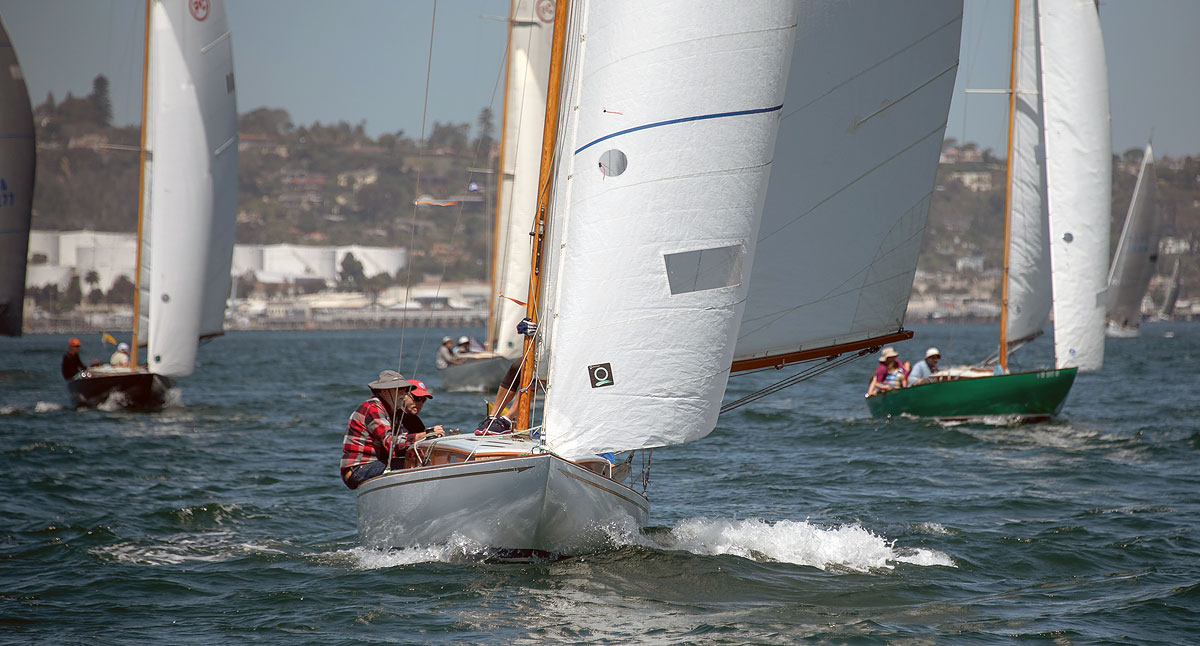
NEPENTHE (No. 62) leads the fleet at the 2019 SDYC Opening Day. She is owned by Rick Arneson, who is new to the fleet and also an avid Snipe sailor. In the background from left to right are FIRST FIDDLE (No. 11), JEWEL (No. 35), and ONION TRUCK (No. 21).
Pacific Class sloops did not spring from the drawing board of a celebrity yacht designer of the 1920s, the likes of Nathanael Herreshoff, Starling Burgess, or B.B. Crowninshield. Rather, PCs came from a local San Diego builder named George Kettenburg, Jr. (see sidebar, page 36), whose shop was then a backyard operation according to Danielle Richards, the current class secretary. She’s got an impressive history of class racing in all sorts of traditional and modern dinghies, but smiles when she confesses her preference for PCs and their improbable origins. A native San Diegan, she takes more than a little pride in the fact that PCs are homegrown.
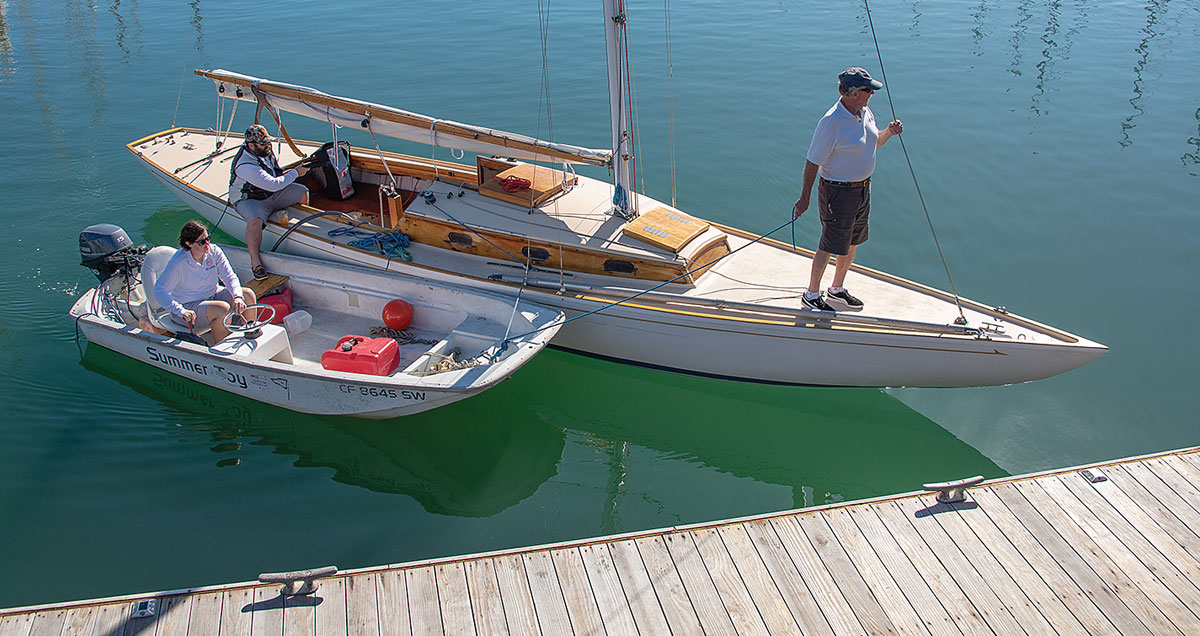
The ROUTE 66 crew maneuvers to the dock before the first of the 2019 Sun Series Races. The boat’s cabinhouse extends forward of the mast, which means she was built after World War II.
Pavelec, who in addition to rescuing the boats is a PC owner and an SDYC member, sets the scene on the club’s website: “The year was 1929. Herbert Hoover was president of the United States. The stock market had crashed. Within the last 10 years, the population of San Diego had exploded from 74,361 in 1920 to a whopping 147,995 people by 1930. On the waterfront in San Diego Bay, the now-popular Shelter Island was still a natural bar of sand, accessible only by boat. Those taking the trolley out to the commercial basin area or Roseville could see Star-boats, Starlets, R-boats, 6-Meters, and such racing in the bay.”
Aboard one of those boats was Joe Jessop, a nationally known and well-traveled regatta competitor with a soft spot for Herreshoff’s S-class daysailers (see WB No. 267). According to PC fleet lore, Jessop came back to San Diego after some East Coast racing in Herreshoff boats and asked why there was no boat specially built for Southern California winds and waters that could compete in the S class.
In the summer and fall of 1929, a collection of avid SDYC racers pondered this question as they searched for a one-design boat better suited than S boats (with their rather blunt ends) for the unusual combination of moderate winds but choppy seas and ocean swells typical of Southern California. The racers admired the long, lean look of a 22-square-meter imported from Norway. But they were truly infatuated with the smaller and less expensive Starling Burgess-designed Atlantic class sloop.
Just as they were placing an order for four Atlantics, Kettenburg, then 25 years old, made the yachtsmen an offer they couldn’t refuse. He could build a boat with the sail-carrying ability and sweet overhangs of the meter boat and the light displacement of the Atlantic class. But unlike the Atlantic’s open cockpit, Kettenburg’s boat would have decking and a cuddy cabin for safety and comfort during open-ocean sailing. The cuddy would also give the crew a place to sleep aboard when taking the boat to race up the coast at Dana Point, Newport Beach, Long Beach, Los Angeles, or further north. Kettenburg said he could build his prototype within the rules of the S class and at absolutely no cost to the yachtsmen.
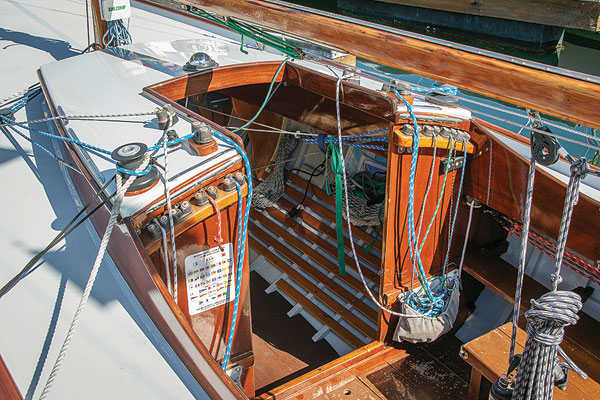
LA CUCARACHA (No. 14, pictured here) and some other PCs have elaborate control consoles on either side of the companionway; others are rigged minimally.
The young shipwright promised that he and Jessop would race his prototype against the 22-square-meter and local Herreshoff R-boats. If the Kettenburg boat won…well, how about some contracts? He thought he could sell the boats for $2,100, complete with sails—two-thirds the cost of an Atlantic. He would call his boat the Pacific Class in bold defiance of the dominance of East Coast designers and builders in yachting circles of the era.
With only a high-school education and no training as a naval architect, Kettenburg drew on his exceptional eye for speed, beauty, and sail-carrying qualities and got to work carving a half model of his concept for a Southern California inshore racer. After lifting the offsets from the model and laying the lines out on the lofting floor, he had the plan for a sleek, light-displacement, fin-keel knockabout sloop with low freeboard and long overhangs. The hull measured 31′10″ LOA, with an LWL of 21′ and a beam of 6′8″. The draft was 4′6″, and the displacement was 5,000 lbs. The fractional sloop rig carried 385 sq ft of sail.
Four months after carving the model, Kettenburg had built a boat that stood out not only for its light displacement and swift looks, but also for its light construction. He built the keel of Douglas-fir. Frames were steam-bent white oak measuring only 11/8″ × 11/8″ on 8″ centers. Planking was ¾″ Philippine mahogany fastened with bronze. The decks were spruce. The boat carried about 2,450 lbs of outside lead ballast. Kettenburg named his creation SCAMP.
Jessop and Kettenburg sailed SCAMP in a test race, where she dominated the R-boats and the 30-square-meter. The SDYC had its new class racer. Despite the stock-market crash of October 1929, what was to become Kettenburg Boat Works had orders for PCs and there was an organized class association. By 1931, Kettenburg had built six more PCs for customers at the yacht club.
At this point, Jessop, acting as both a promoter for Kettenburg and an emissary of the SDYC, challenged the East Coast S-boat sailors to a four-boat match race in Honolulu. The PCs won, and they grabbed headlines for their victories.
Hawaiian sailors purchased the four PCs that raced in Honolulu, and their former owners placed orders with Kettenburg for new PCs. Additional orders started arriving from up and down the West Coast. By the start of World War II, Kettenburg had built 35 of the boats, and other builders on the West Coast and Hawaii were soliciting permission to build them.
As time passed, the interior and deckhouse on the PC evolved. Kettenburg added a forward V-berth and small galley to some boats. He also tried a raised doghouse to improve headroom, but the concept was short-lived.
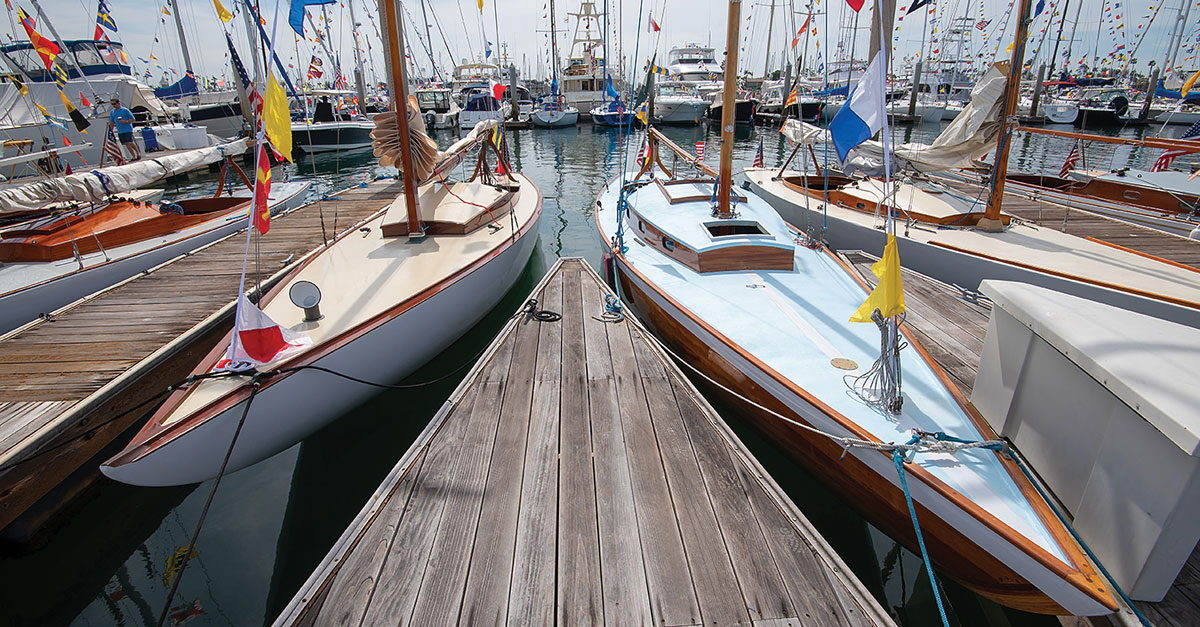
It’s easy to see the small variations in a PC’s deck and cabin arrangements when TRADEWIND (No. 27), DAWN (No. 16), CARL M. EICHENLAUB (No. 84), and YANKEE (No. 72) are lined up and dressed for the SDYC Opening Day festivities.
A huge U.S. market for recreational watercraft followed WWII, and the PC was once again in high demand. With the orders coming in, Kettenburg ruminated on what he had learned from building his fleet of PCs and decided he could improve the rig by changing the headstay position and a few other details. He also stretched out the deckhouse and added a head to make PCs at least seem as if they could be potential weekend cruisers.
There was one other big change. Having built scores of small boats for the Navy during the war, Kettenburg Boat Works was now a “production” boatbuilder, and the yard’s construction team had learned about the efficiencies of building hulls upside down on a jig, so Kettenburg began building PCs this way as well. The company also licensed construction of a few hulls to a builder in British Columbia. Some bare hulls were built in San Diego, then shipped upside down via rail to a Seattle builder to finish.
The last Kettenburg PC, No. 83, rolled out of the shop in the late 1950s. But PCs did not vanish with the fiberglass revolution in boatbuilding. According to Pavelec, perhaps as many as 30 PCs are still actively sailing.
As one generation of PC owners faded away in the 1990s, a new gathering of angels comes into the picture—namely Bud Caldwell (Alex Caldwell’s father), Morgan Miller, and AMERICA’s Cup skipper Jack Sutphen. They began scooping up PCs that were being neglected. “They had a habit of inviting people for a nice Saturday sail in a PC,” says Richards, amid sheet-handling aboard DAWN, “and when the sail was over and the guest was gushing about the ride, these guys would say, ‘and by the way, here’s your new boat. Welcome to the fleet.’”
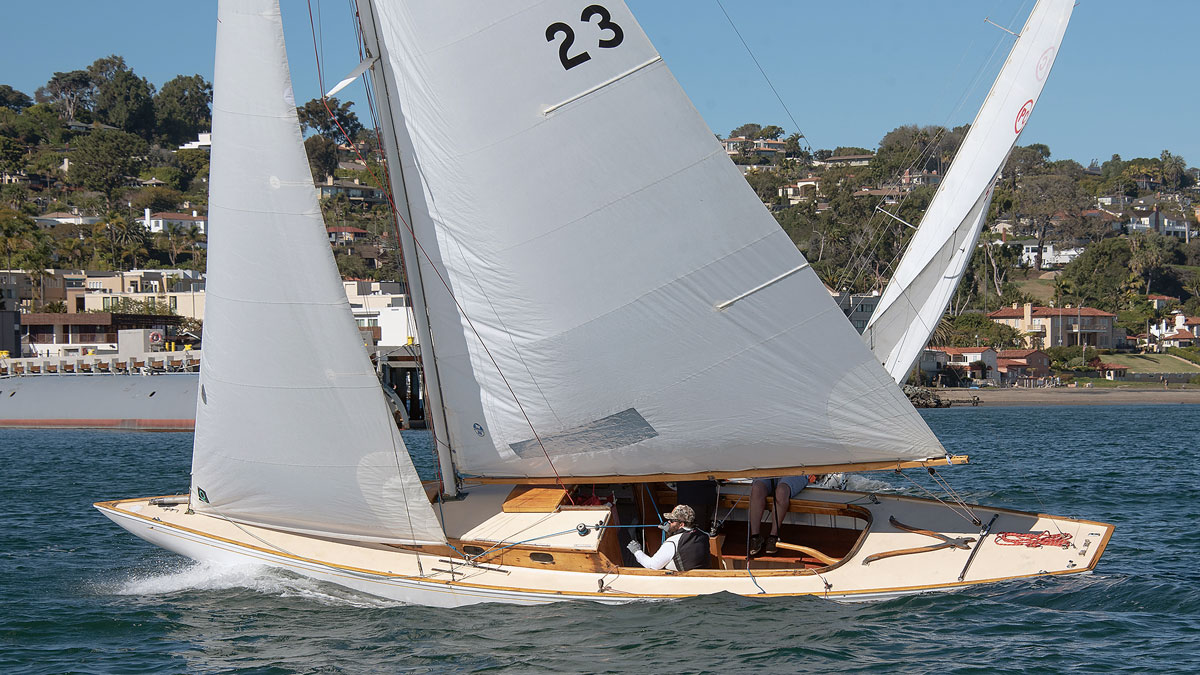
Danielle Richards and Seth Johnson crew with ROUTE 66’s owner, Brent Boyd. Boyd borrowed a mainsail from them to test a different cut while Richards and Johnson are currently having their PC, CHAOS (No. 23), restored.
Richards says that when she was a junior sailor at the SDYC she would walk past the PCs on E Dock almost every day on her way to sail dinghies with the sailing school. It wasn’t long before Bud Caldwell noticed her. He was a longtime employee at Kettenburg, and by the 1980s had been on hand for the development and building of more than a half-dozen Kettenburg designs. But he had a soft spot for PCs, especially his own boat, ONION TRUCK.
“Bud would see me coming down the dock,” says Richards, “and he would ask me what I was doing on Saturday. If I didn’t have a quick response, he drafted me to crew on ONION TRUCK for a race.”
So it was with a core group of junior sailors at SDYC. And while the PC fleets in places such as Newport Beach, Los Angeles, and Santa Barbara began to disappear as a generation of owners crossed the bar, the San Diego fleet more than held its own. Today, Richards is one of three PC owners in their early 30s who race with a crew of young cohorts.
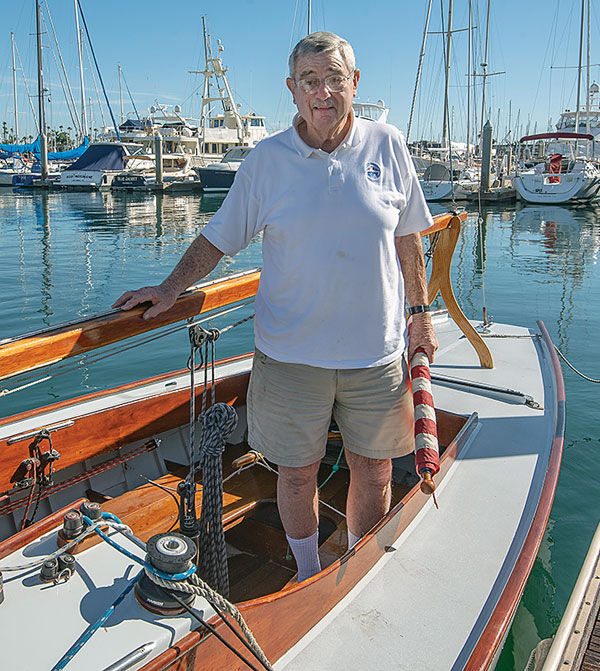
Longtime fleet member George Lindley, seen here aboard his 1935 PC LA CUCARACHA (No. 14), has been sailing PCs his whole life. LA CUCARACHA is the most successful PC in the class’s history, having taken numerous National and Fleet Championship titles.
Pavelec was also among the novices drawn into the fold by a casual invitation to sail in a PC. “My eyes popped out of my head,” he recalls about his first sail, “I fell in love.” The next thing he knew he had made an offer on a PC and raced home on his Harley to clean the house and cook dinner before he sprung it on his wife that he had just bought a 50-year-old boat that he “didn’t know how to sail.”
The rest is history. Since those days, Pavelec has owned seven PCs, gone as far as Alaska to rescue a boat from oblivion, sold some of the boats to bring new blood into the San Diego fleet, and restored several with the help of Koehler.
For Alex Caldwell, owning and maintaining what he still thinks of as his father’s PC is about his connection with his father and his mother. He’s a busy family physician in central California, but as often as he can, he drives four to five hours to San Diego to sail ONION TRUCK.
“My wife and I actually sleep aboard,” he says. “I see my dad everywhere in that boat.” And what memories it brings back. He remembers his final years of sailing ONION TRUCK with his father in a race called Men’s Mayhem, when they both qualified as senior citizens. But the PC also brings back memories of youth, like the time his dad asked Caldwell, then 15, and a couple of his friends to deliver a PC about 135 miles north to a regatta at Marina Del Rey.
“We didn’t have an engine, and we spent about a day becalmed off Oceanside, then again just outside Avalon Harbor [on Santa Catalina Island]. It took us four days before we sailed into Marina Del Rey.” ONION TRUCK taught the boys a lot about seamanship and seafaring adventure.
Sometimes Caldwell thinks that it’s crazy for him to keep his dad’s PC when he lives so far from San Diego. “But I’m hoping to get my grandkids interested in it,” he says. So he’s not letting go.
There’s no doubt that owners’ emotional connections to PCs have ensured their survival for far longer than Kettenburg could have imagined. The characters of the people who have sailed them for more than three generations have played a role in this, too—as have the beauty of the boats and the thrill of sailing them.
In recent years, there has been a new flurry of PC restorations. Koehler has been engaged in seven of these at his yard on Shelter Island in recent years. He tells a surprising story for a shipwright who once believed that classic yachts deserve restorations using traditional methods and materials.
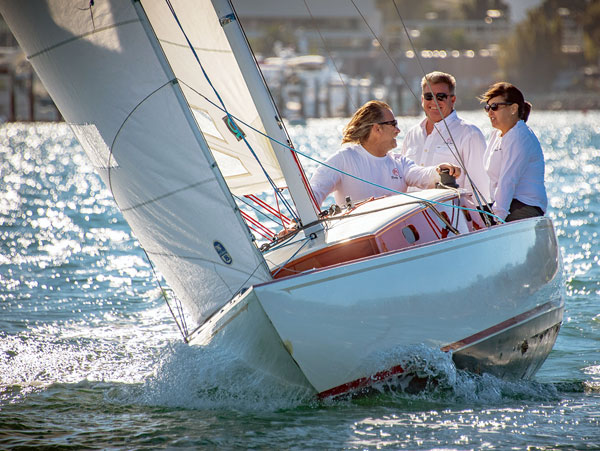
Steve and Heather Brownsea (seated astern and on the port rail) with guest crew take their ZEST on a reach to the finish line on the first of the three races of the 2019 Sun Series Trophy. Steve bought her in 2011 from the defunct Marina del Rey fleet and has been restoring the boat himself ever since.
“Bud Caldwell had a tired and leaky PC,” says Koehler. As a surfer, Caldwell knew the ins and outs of making repairs with resins. “So he decided to stop the leaks in his boat by recaulking the seams with polyester line soaked in epoxy, then coating the hull in epoxy.”
Purists scoffed. They thought it would never work, says Koehler. “But years went by. The boat won races, and it didn’t fall apart. It seemed to me maybe this guy had hit on something.”
But while Koehler and a number of PC owners were evolving variations of this epoxy method to add strength and stop the leaks in aging hulls, an amazing thing happened. The legendary Shelter Island boatbuilder Carl Eichenlaub decided he was ready to build his last boat, and that he wanted it to be a PC. He had been the U.S. Olympic Sailing Team shipwright from 1976 until 2004 and was a builder of world-champion Star-boats. So, after gaining the necessary permissions from the Kettenburg family, Eichenlaub set about crafting the first new PC to join the fleet in nearly 50 years. Traditionally constructed, hull No. 84 took to the water in 2004. Eichenlaub presented it as a gift to his daughter, Betty Sue Sherman, to celebrate her appointment as the first female commodore of the SDYC. She returned the gesture by naming her new PC the CARL EICHENLAUB.
At about the same time Eichenlaub was building his PC, a number of other owners were completing restorations. One was Koehler’s ground-up, stem-to-stern restoration of DAWN for Pavelec.
“About the only thing we saved was the ballast,” Pavelec says. “I hate to think how much money I’ve spent on these boats. But I’d do it all again. They have given me such joy.”
He says this like a man declaring to the world that you can’t put a price on perfection or on beauty. And when that thing can soar? There will be legends. And there will be angels—many different kinds along the way.
Randall Peffer is a regular contributor to WoodenBoat. His latest book is Never to Return: Surviving the Worst Combat Loss in the History of the U.S. Coast Guard.
ACCESS TO EXPERIENCE
2-for-1 Print & Digital Subscription Offer
For this holiday season, WoodenBoat is offering our best buy one, get one deal ever. Subscribe with a print & digital subscription for $42.95, and we’ll give you a FREE GIFT SUBSCRIPTION to share with someone special.
1 YEAR SUBSCRIPTION (6 ISSUES)
PLUS ACCESS TO MORE THAN 300 DIGITAL BACK ISSUES
PRINT+DIGITAL $42.95
Subscribe
To read articles from previous issues, you can purchase the issue at The WoodenBoat Store link below.
